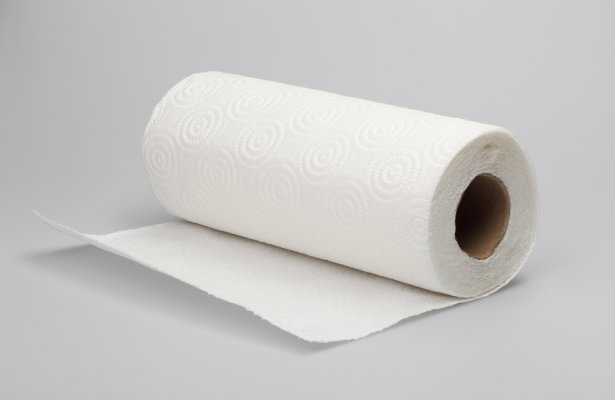
Here are some examples of what you can change:
1. Paper towels for drying hands and dishes - Get good quality hand towels and dish towels that are very absorbent. Have a separate dish towel so when you are drying your clean dishes, you don't feel like you are rubbing a dirty towel over them (as hand towels tend to get dirty faster, even if your hands have just been cleaned). Of course have a few so you can rotate them while you do laundry.
2. Paper towels for cleaning the house - Use rags! You can purchase towels specifically for the purpose of cleaning, or you can cut up old t-shirts you no longer use. Rags work for everyday cleaning such as bathrooms, dusting, etc. but I realize that paper towels are sometimes needed for cleaning up food spills, or during cooking (like for patting raw chicken dry, you wouldn't use a rag). Just recycle the cardboard roll inside.
3. Paper napkins - Get some cloth napkins and don't be afraid of using them! I know it feels weird to smear your food all over cloth sometimes, but that's what they are for. Don't get light colored ones that will stain easily, unless you get white and you plan on bleaching them. I recommend dark colored, even black napkins for everyday use. Make sure whatever you buy, that they are washer and dryer friendly. I personally have a bunch of these black napkins from Bed Bath & Beyond and I love them. They look sleek and sophisticated for fancy dinners, but are durable enough for everyday use. They don't stain, fade, or stretch out.
4. Paper plates - Okay I get it, paper plates are so handy for going on picnics, delivering food to someone, or packing a lunch (but reusable lunch containers are also a thing). It's okay to make exceptions, we're starting small here, remember? But sitting in your house, eating a normal meal, just use a normal plate and wash it. It's really not that hard. If you want to reduce the amount of dishes to clean, you could always quick rinse off and reuse your lunch plate for dinner instead of creating two dirty plates.
5. Toilet paper - Just kidding. Please keep using toilet paper, just recycle the cardboard roll. I am totally guilty of not doing that, since I keep throwing it out in the bathroom trash can. Perhaps I need a special cardboard roll container in the bathroom. I've seen some toilet paper on the market that no longer have the cardboard roll, but I have never used them so I can't tell you how well they actually roll. If you have experience with tube-less toilet paper, let me know in the comments your opinions on them.
Any other suggestions on how to cut back on paper products in the house? Please comment to let me know!
Look forward to a future post about how to cut back on disposable plastic products in the house, as well as one that will talk about brands that make paper products out of 100% recycled materials.
Image Source
I actually do have a friend that has little scraps of cloth in a basket behind the toilet that they use in addition to toilet paper (toilet paper for solids, cloth for liquids).
ReplyDeleteI definitely need to use dish towels more - I use SO many paper towels. I guess the first step is to actually do laundry more often >_<
Wow, using cloth for toilet paper is dedicated! Something I don't think I could ever get into. But good for them.
DeleteYes, it does mean doing laundry more. We use our cloth napkins many times before they get washed (depending on how messy our food is), but I imagine families with kids would make a lot more mess and thus more laundry.
I wish households were set up to reclaim grey water more, and even then, putting the grey water through a basic filter system and then into a rain garden.
ReplyDeleteI agree! By going this route you definitely do more laundry and use more water, so reclaiming gray water would be pretty cool.
Delete